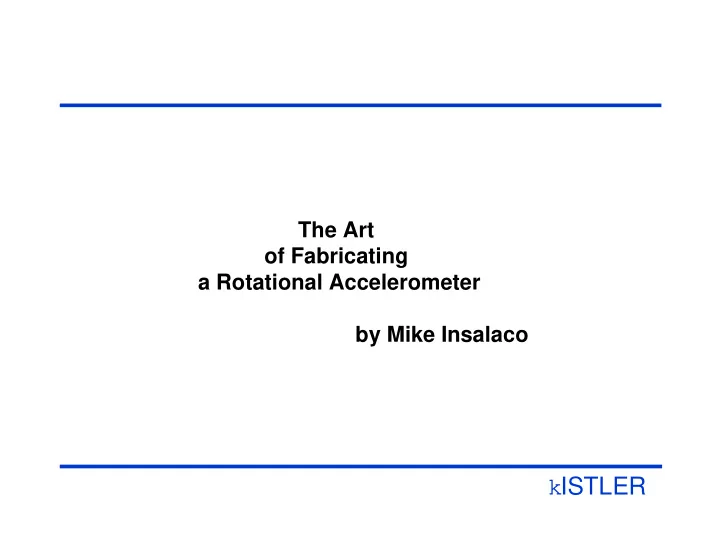

The Art of Fabricating a Rotational Accelerometer by Mike Insalaco k ISTLER
The Art of Fabricating a Rotational Accelerometer OBJECTIVE ● Briefly review the need for a device ● Discuss difficulty using commercial hardware ● Review suitable sensor technologies ● Describe successful assembly & test techniques k ISTLER
Rotational Accelerometer: Need for the device ● Structural testing and vehicle collision studies require rotational data ● FEA- Surface displacements and rotations are considered in the computer model where each of them represents a degree of freedom (DOF) of the system k ISTLER
Rotational Accelerometer: Using Commercial Hardware ● Spatially separated and sensitivity matched linear accelerometers can be used to estimate rotational acceleration ● Inherent sensor imperfections including misalignment, transverse sensitivity, etc., contaminate the computed result k ISTLER
Rotational Accelerometer: Using Commercial Hardware ● Prevailing levels of output signal generated by the translational components of the structure’s movement tend to overshadow those due to the rotational motions ● This undesirable ratio places a high precision requirement on the sensitivity matching process k ISTLER
Rotational Accelerometer: Technology Tailored Designs ● Producing an accurate rotational accelerometer from commercially available hardware is a tremendous task ● Manufacturers of accelerometers have more control over the sensitivity matching process and can incorporate technologies which have the qualities required by the design constraints of an accurate rotational accelerometer k ISTLER
Rotational Accelerometer: Technology Tailored Designs ● Experimental Modal Analysis (EMA) is a field of study which predominately incorporates a sensor well suited for the following conditions/characteristics: low frequency range < 1000 Hz; moderate and controlled environmental conditions; excellent immunity to transverse inputs; lightweight package; and high output sensitivity ● A bimorph is an ideal piezoelectric element for this set of conditions k ISTLER
Accelerometer Design - Bimorph Based ● Constructed from two inversely polarized piezoelectric plates that are sandwiched together and sliced to form a rectangle ● The piezoelectric element also serves as the seismic mass since it is mounted in a manner allowing ‘beam’ flexure when exposed to acceleration k ISTLER
Accelerometer Design - Bimorph Construction Bimorph plate 0.2” x 0.6” x 0.02” Central Support a k ISTLER
Rotational Accelerometer: Assembly Techniques k ISTLER
Rotational Accelerometer: Test Techniques k ISTLER
Rotational Accelerometer: Technology Tailored Designs ● Automotive crash studies have identified rotational acceleration as a tremendous influence regarding damage to humans during a vehicle collision ● A shear construction quartz based design is well adapted to this environment k ISTLER
Accelerometer Design - Shear Quartz Construction V C1 q1 C2 q2 V = (q1+q2) / (c1+c2) k ISTLER
Rotational Accelerometer: Assembly Techniques ● The charge presented by each half of the seismic system, q1 and q2, are dependent solely on each half’s total mass (sum of quartz plates, masses, & preload bolt) ● Each side can be matched for identical weight using a static weighing process - dynamic sensitivity measurement is needed only for calibration constant k ISTLER
Rotational Accelerometer: Test Techniques k ISTLER
The Art of Fabricating a Rotational Accelerometer CONCLUSION Reviewed the need for a rotational accelerometer ● Discussed problems associated with the use of commercial hardware ● Technologies with appropriate features were reviewed ● An overview of assembly & test techniques was presented ● k ISTLER
Recommend
More recommend